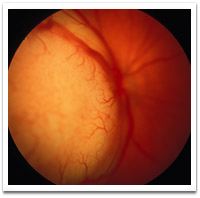1- Retinoblastoma:
– Characterized by its early onset (children 2 to 3 years) and bilateralism and are frequent genetic trait
– The development exophytic tumors do not form a protruding mass, but causes a retinal detachment
– Pejorative factors: damage to the optic nerve; choroïdosclérale invasion
Presentation is
– Leucorie (amaurotic cat eye)
– Unequal pupil; mydriasis
– Nodular type of uveitis; sometimes pseudo-hypopyon;
– Rubeosis iris
– Other: Unilateral buphthalmos, Hyphema, strabismus or nystagmus;Cataract.
2- choroidal melanoma:
– This is the most common malignancy of over 50 adult
– CDD: decreased visual acuity; progressive glaucomatous visual fields;metamorphopsia; scotoma.
– Clinical signs: dilated episcleral Vx; Corneal hypoesthesia; stopping transmission of light at the scleral transillumination.
– Treatment if small tumor => proton therapy.
* Capillary hemangiomas (benign tumor) are the most common tumor of the orbit in children; he produced a progressive exophthalmos; disappear spontaneously
* The cavernous hemangiomas (adult) does not devolve
3- Tuberculosis:
* Keratoconjunctivitis phlyctenular
* Interstitial keratitis: nodular infiltrates deep -> pillowcases
* Acute Iridocyclitis (precipitated candle tasks)
* Tuberculous choroiditis: scattered follicles (tubers Bouchut)


Leave a Reply